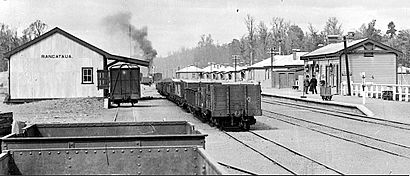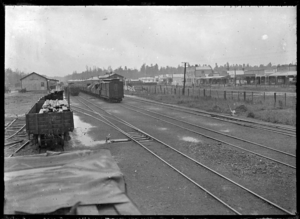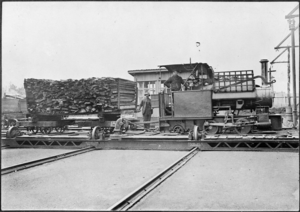Rangataua railway station facts for kids
Quick facts for kids
Rangataua railway station
|
|||||||||||
|---|---|---|---|---|---|---|---|---|---|---|---|

Railway station Rangataua 1910s
|
|||||||||||
| Location | New Zealand | ||||||||||
| Coordinates | 39°25′35″S 175°27′26″E / 39.42638°S 175.45713°E | ||||||||||
| Elevation | 670 m (2,200 ft) | ||||||||||
| Line(s) | North Island Main Trunk | ||||||||||
| Distance | Wellington 312.66 km (194.28 mi) | ||||||||||
| History | |||||||||||
| Opened | in use from 31 May 1907 goods 12 August 1907 passengers 15 February 1909 |
||||||||||
| Closed | goods 19/9/1986 passengers before December 1975 |
||||||||||
| Electrified | June 1988 | ||||||||||
| Services | |||||||||||
|
|||||||||||
Rangataua was a railway station in the Ruapehu District of New Zealand. It was an important stop on the North Island Main Trunk (NIMT) railway line. Like many stations in this area, Rangataua was busy because of the huge timber industry. People cut down native forests, which were then transported by train. The small village of Rangataua grew up just south of the station. Today, only a single track remains, and almost nothing is left of the once busy station and its workshops.
Contents
History of Rangataua Station
Building the Railway Line
Work began on surveying the railway route between Hīhītahi and Piriaka in 1894. Clearing the native forest for the railway tracks started in 1900. The railway tracks reached Rangataua station on May 31, 1907. A special passenger train, carrying important people and reporters, arrived in July of that year.
Opening for Goods and Passengers
The line from Waiouru to Rangataua officially opened for goods trains on August 12, 1907. A stationmaster, who was in charge of the station, was appointed in August 1907. By September 1907, there were plans for passenger trains to run from Mataroa to Rangataua.
Station Buildings and Facilities
Between 1907 and 1908, a small workshop was built at Rangataua during the railway's construction. This workshop had a plumber, a carpenter, a painter, a store, and a blacksmith. More machines were added in 1912, and a new shed in 1928.
By September 1909, a standard "3rd class station" building was completed. It cost about £11,000, which also covered the workshops and homes for railway staff. These staff included an inspector, a stationmaster, and two platelayers (who maintained the tracks). Five railway cottages were built by 1908, and some were moved from Waiouru to Rangataua in 1909. The stationmaster's house got hot water in 1912, and the other cottages in 1915. There were also plans to add electricity to the cottages in 1914.
When it first opened, Rangataua station had several rooms. These included a stationmaster's office, a ticket office, a waiting area, a luggage room, and separate restrooms. The station had a platform that was about 91 meters (300 feet) long and 4.5 meters (15 feet) wide. There was also a goods shed, a loading area for cargo, and yards for cattle and sheep. The station used a special "tablet" system and fixed signals to control train movements safely. A water tank was added in 1910. The station also had a "crossing loop," which was a side track long enough for 60 wagons to wait while another train passed.
Station Decline and Closure
As the timber industry slowed down, the station became less busy. In 1934, Rangataua was changed to a "tablet station" that could be "switched out." This meant it could be temporarily closed when not needed, saving staff costs. On February 28, 1959, the station lost its stationmaster, meaning it was no longer a main staffed station. Approval to remove the station building was given in 1971. Finally, on September 19, 1986, Rangataua station closed completely to all train traffic.
Timber Industry at Rangataua
Timber Mills and Transport
The table below shows that timber traffic was highest in 1913 and then dropped quickly after 1930. Several timber mills operated near Rangataua. For example, R. A. Wilson wanted a side track in the station yard in 1907. Perham & Larson asked for a side track about 400 meters (20 chains) south of the station in 1908. The Rangataua Timber Co., started in 1907, also wanted to make their side track longer in 1908.
Perham & Larson had about 4 hectares (10 acres) of land in 1909. In 1910, they sent timber to Lower Hutt. Their private side track was about 2.4 kilometers (1.5 miles) from the station. Perham, Larson & Co. also had a special railway, called a tramway, with a Climax loco (a type of steam engine) from about 1909 until 1944. The Waiakaki Sawmilling Co. had a tramway from around 1928 to 1933. In 1940, Marton Sash & Door Co. was still cutting timber in the area.
Powell Wood Process Ltd.
In 1908, a new sawmill and wood treatment factory were built to create "Powellised timber." This special timber was supposed to resist rot and insect damage. The company had rights to cut down about 1,782 hectares (4,402 acres) of native forest. This forest contained trees like rimu, matai, kahikatea, māpou, kāmahi, and hard beech.
The factory was connected to the forest and the main railway line by a tramway. This tramway stretched about 9.6 kilometers (6 miles) towards Mount Ruapehu. The total cost of this project was around £30,000. A photo from 1910 shows people on horses following the tramline on their way to the mountain. In 1913, there were plans for the tramway to be 11.2 kilometers (7 miles) long. The factory expanded in 1909 and 1911. However, a report in 1915 questioned if the special wood treatment really worked. After the factory burned down in the Raetihi Forest fire of 1918, the company closed down. Still, a 1930 report noted that Powellised timber used for paving in Auckland had lasted very well.
Station Usage and Traffic
Passenger and Timber Numbers
The table and graph below show how many people used Rangataua station. Like many NIMT stations, the number of passengers was highest during World War II. After the war, passenger numbers dropped to about 25 people per day.
However, Rangataua was very important for timber transport. By 1913, it was the third busiest NIMT station for timber volume. By 1910, it was sending out an average of 25 wagons of timber every day. Shortages of workers during World War I, the 1918 fire, and land being used for farming instead of forests, all led to less timber traffic. But as timber traffic went down, the number of sheep in the area went up. Sheep numbers rose from 1,222 in 1913 to 12,662 in 1949.
| year | tickets | season tickets | timber superficial feet | staff |
| 1908 | 1,040,000 | 2 | ||
| 1909 | 648 | 2 | 4,664,300 | 6 |
| 1910 | 4,603 | 9 | 4,984,600 | 4 |
| 1911 | 5,865 | 2 | 9,279,400 | 4 |
| 1912 | 5,876 | 3 | 11,285,100 | 5 |
| 1913 | 5,955 | 6 | 13,449,800 | 7 |
| 1914 | 5,721 | 22 | 10,762,800 | |
| 1915 | 6,551 | 10 | 8,957,300 | |
| 1916 | 5,930 | 26 | 8,925,200 | |
| 1917 | 5,908 | 77 | 6,447,000 | |
| 1918 | 6,101 | 77 | 5,706,600 | |
| 1919 | 6,779 | 63 | 5,431,700 | |
| 1920 | 7,886 | 117 | 7,010,100 | |
| 1921 | 9,678 | 106 | 6,951,800 | |
| 1922 | 10,138 | 80 | 5,525,200 | |
| 1923 | 11,807 | 69 | 4,385,500 | |
| 1924 | 11,778 | 137 | 5,187,300 | |
| 1925 | 10,607 | 72 | 5,204,000 | |
| 1926 | 12,219 | 133 | 6,265,800 | |
| 1927 | 10,737 | 73 | 5,758,400 | |
| 1928 | 8,867 | 72 | 4,716,800 | |
| 1929 | 9,511 | 26 | 5,466,200 | |
| 1930 | 8,607 | 32 | 5,723,500 | |
| 1931 | 12,668 | 38 | 4,044,400 | |
| 1932 | 12,228 | 71 | 2,723,500 | |
| 1933 | 14,152 | 118 | 1,839,200 | |
| 1934 | 13,301 | 76 | 1,386,600 | |
| 1935 | 14,813 | 72 | 1,366,900 | |
| 1936 | 17,980 | 94 | 2,008,200 | |
| 1937 | 18,222 | 110 | 1,335,400 | |
| 1938 | 17,308 | 82 | 980,500 | |
| 1939 | 17,278 | 73 | 1,771,600 | |
| 1940 | 21,799 | 53 | 1,574,300 | |
| 1941 | 25,186 | 43 | 1,916,800 | |
| 1942 | 21,100 | 24 | 1,862,100 | |
| 1943 | 21,528 | 17 | 2,548,400 | |
| 1944 | 19,630 | 12 | 1,680,500 | |
| 1945 | 17,938 | 1,773,700 | ||
| 1946 | 18,049 | 1,748,100 | ||
| 1947 | 14,585 | 1 | 1,837,700 | |
| 1948 | 9,986 | 2 | 1,256,500 | |
| 1949 | 10,181 | 1,434,800 | ||
| 1950 | 9,030 | 950,100 |




